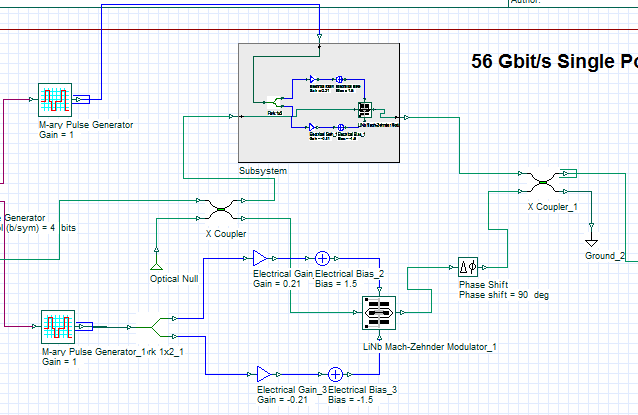

- #MACH ZEHNDER MODULATOR DOES NOT EXIST IN OPTISYSTEM 14 INSTALL#
- #MACH ZEHNDER MODULATOR DOES NOT EXIST IN OPTISYSTEM 14 UPGRADE#
- #MACH ZEHNDER MODULATOR DOES NOT EXIST IN OPTISYSTEM 14 FULL#
In silicon photonics, the light is mostly guided in silicon, which has an indirect bandgap of 1.12 eV (1.1 μm). This article focuses on silicon photonics. From left to right there are silica-on-silicon PICs, also called PLCs silicon-on-insulator PICs, also called silicon photonics lithium niobite (LiNbO 3) and III–V PICs, such as InP and GaAs. The next step, the CFP2, allows only 12W.įigure 4 shows the most popular PIC material systems. Power consumptions have gone from more than 100 W on a line card, to 70 W for the screwed-on module, to 28 W for the CFP. Tomorrow's will be a CFP2, which is half the size, and eventually a CFP4, which is a quarter the size. Today's 100-Gb/s pluggable form factor is called a CFP.
#MACH ZEHNDER MODULATOR DOES NOT EXIST IN OPTISYSTEM 14 FULL#
As seen in Figure 1, 100-Gb/s modules have gone from full line cards to 5 × 7 in 2 screwed-on modules to 3.2 × 5.7 in 2 pluggable modules today.

However, not only must the price drop, but the footprint and power consumption as well. This is because users want to pay the same price per connection even though the bit rate keeps increasing. However, the price of 100-Gb/s coherent transceivers is expected to drop significantly. Industry analyses show the number of metro and long-haul 100-Gb/s coherent transceivers sold per year to be on a steep upwards ramp as 10-Gb/s OOK transceivers are replaced by 100-Gb/s coherent transceivers.
#MACH ZEHNDER MODULATOR DOES NOT EXIST IN OPTISYSTEM 14 UPGRADE#
They allow an upgrade of a 10-Gb/s channel to a 100-Gb/s channel with actually improved reach. Now it is dual quadrature and dual polarization.ġ00-Gb/s coherent systems have proven to be extremely compelling. In the past, coherent detection was simply single quadrature and single polarization. With improvements in complementary metal-oxide-semiconductor (CMOS) electronics, digital signal processing (DSP) became available circa 2002 to handle coherent detection even up to 100-Gb/s, causing a revival of coherent detection. Another advantage of coherent detection is the ability to receive the full optical field, both the real and imaginary parts of both polarizations. However, the invention of the erbium-doped fiber amplifier (EDFA) eliminated that advantage and coherent interest died away. Optical coherent detection was a hot topic in the 1980s, because it is a form of optical amplification. Optical coherent detection allows this to be done by digital electronics. To unscramble them requires significant signal processing. Although signal orthogonality is maintained, their polarizations are essentially randomly changed during propagation through fiber. One key way is to use both optical polarizations, because this doubles the available bandwidth.
#MACH ZEHNDER MODULATOR DOES NOT EXIST IN OPTISYSTEM 14 INSTALL#
It is expensive to install new optical fibers, ~$30 k per mile, so carriers and data-center operators needed to send more bits per second in the same fiber in the same optical bandwidth. However, bandwidth needs have been constantly growing exponentially. Early BSPK and QPSK were detected by differential detection, i.e., by interfering one symbol with the previous symbol in an interferometer in the receiver. In these “advanced” modulation formats, the term “symbol” is used to represent each data portion in time, because each symbol can carry multiple bits of information. They maximize the distance between constellation points for the same average signal power.

Higher performance, i.e., a lower bit-error rate (BER) for the same received optical power and/or for the same optical signal-to-noise ratio (OSNR), can be obtained by using phase-modulated formats, such as binary phase-shift keying (BPSK) or quadrature phase-shift keying (QPSK). On-off keying is simply turning on and off the light to transmit “1” s and “0” s. Until circa 2002, fiber-optic communication for metropolitan distances (80-600 km) and long-haul distances (600–15,000 km) employed mostly simple on-off keying (OOK) transmission.


 0 kommentar(er)
0 kommentar(er)
